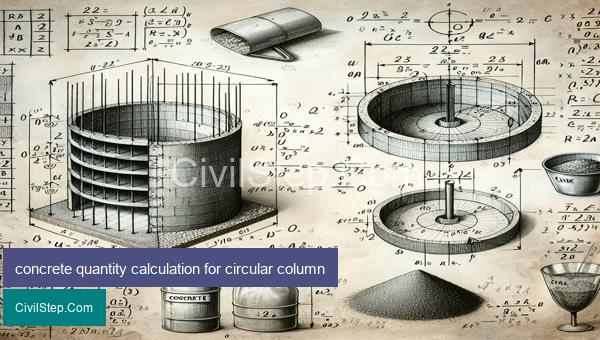
Concrete is a fundamental building material used in construction projects worldwide. It is a versatile and durable material that provides structural integrity and stability to various structures. When it comes to constructing columns, accurate calculation of concrete quantity is crucial to ensure the strength and stability of the column. The process of determining the right amount of concrete required for a column involves several variables and calculations, which can seem daunting to many. In this article, we will take an in-depth look at all the factors involved in calculating concrete quantity for columns, providing readers with a comprehensive understanding of this essential construction process.
How to calculate concrete quantity for column

Calculating the concrete quantity for a column is an essential step in any construction project. It is important to determine the amount of concrete needed for a column to ensure the structural stability and strength of the building. Here are the steps to calculate the concrete quantity for a column:
Step 1: Determine the Column Dimensions
The first step is to determine the dimensions of the column. This includes the length, width, and height of the column. These dimensions are usually provided in the construction drawings.
Step 2: Calculate the Volume of the Column
Once the dimensions are known, the next step is to calculate the volume of the column. To do this, multiply the length, width, and height of the column. The formula for calculating the volume of a column is:
V = L x W x H
Where,
V = volume of the column
L = length of the column
W = width of the column
H = height of the column
Step 3: Determine the Concrete Mix Ratio
The concrete mix ratio is the proportion of cement, sand, and aggregates used in the concrete mix. It is important to know the mix ratio as it will help in determining the amount of each material needed for the column. The mix ratio is usually provided by the structural engineer.
Step 4: Calculate the Total Volume of Concrete
To calculate the total volume of concrete, you need to multiply the volume of the column by the concrete mix ratio. The formula is:
VC = V x M
Where,
VC = total volume of concrete
V = volume of the column
M = concrete mix ratio
Step 5: Consider Concrete Wastage
It is important to consider a wastage factor while calculating the concrete quantity for a column. This is because some concrete is lost during the mixing, transporting, and pouring process. A wastage factor of 5-10% is usually considered in construction.
Step 6: Convert to Weight
After calculating the total volume of concrete, it is important to convert it to weight. This is because concrete is usually sold by weight. The weight of concrete varies depending on the density of the materials used in the mix. The density of concrete typically ranges from 140 to 150 pounds per cubic foot.
Step 7: Determine the Amount of Cement, Sand, and Aggregates
Now, it is time to calculate the amount of cement, sand, and aggregates needed for the column. To do this, multiply the total weight of concrete by the proportion of each material in the mix ratio. For example, if the mix ratio is 1:2:4, the proportion of cement, sand, and aggregates would be 1:2:4.
Step 8: Add Reinforcements
Finally, you need to add the weight of the reinforcement in the concrete, such as steel bars or mesh. The amount of reinforcement required depends on the size and type of reinforcement specified by the structural engineer.
In conclusion, calculating the concrete quantity for a column requires careful consideration of the dimensions, mix ratio, wastage factor, and reinforcements. It is important to be accurate in these calculations to ensure the structural integrity of the building. It is always recommended to double-check the calculations and consult with a professional if needed.
What is minimum size of RCC column

RCC (Reinforced Cement Concrete) columns are essential components of a building’s structural system. They are responsible for supporting the weight of the building and transferring it to the foundation. The size of RCC columns plays a crucial role in the stability and safety of a structure. Hence, it is important to understand the minimum size requirements for RCC columns.
The minimum size of RCC columns primarily depends on the load-bearing capacity and the architectural design of a building. However, there are certain standards and guidelines set by building codes and structural engineers that need to be followed.
According to the Indian Standard Code IS 456:2000, the minimum size of an RCC column should not be less than 9”x9” (225mm x 225mm) for standard structures. This size is suitable for buildings with up to 4 floors. For buildings taller than 4 floors, the size of the columns should be increased proportionately based on the increase in height and load-bearing capacity.
For example, for a 5-story building, the minimum size of an RCC column should not be less than 12”x12” (300mm x 300mm) whereas for a 10-story building, the minimum size should be 15”x15” (375mm x 375mm).
Apart from the height and load-bearing capacity, there are other factors that determine the minimum size of an RCC column:
1. Type of structure: The minimum size of an RCC column may vary depending upon the type of structure, whether it is a residential, commercial or industrial building. For instance, the size of columns in industrial buildings may be larger due to the heavy machinery and equipment involved.
2. Column spacing: The spacing between columns also plays a significant role in determining their size. The farther apart the columns are, the larger they need to be to support the weight of the structure effectively.
3. Type of construction: The minimum size of an RCC column may also differ for different types of construction methods, such as framed structures, load-bearing structures, and shear wall structures.
4. Soil condition: The type and quality of the soil on which the structure is built also impact the size of the RCC column. In areas with weak soil, larger columns are required to distribute the load evenly and prevent sinking or settling of the structure.
It is important to note that the minimum size of an RCC column may also vary for seismic zones. In areas with high seismic activity, larger and stronger columns are recommended for added stability and safety.
In conclusion, while 9”x9” (225mm x 225mm) is the minimum size of an RCC column for most standard structures, it is not a one-size-fits-all approach. The size of an RCC column needs to be determined carefully by considering various factors to ensure the safety and stability of the structure. It is essential to consult a structural engineer to determine the appropriate size of RCC columns for a specific building design.
Types of column according to shape of column

Columns are one of the most commonly used structural elements in civil engineering. They are vertical members that support the weight of a structure and transfer it to the ground. Columns are designed to withstand compressive forces and can come in a variety of shapes, depending on the specific structural design requirements. In this article, we will discuss the different types of columns based on their shapes.
1. Rectangular or Square Columns:
These are the most commonly used types of columns in building construction. They have a rectangular or square cross-section and are used to support light to moderate loads. These columns are easy to construct and can be reinforced with steel bars for added strength.
2. Circular Columns:
These columns have a circular cross-section and are used to support heavy loads. They are commonly used in bridges, water tanks, and other structures that require a high load-bearing capacity. Circular columns also provide an aesthetically pleasing look to the structure.
3. Elliptical Columns:
These are similar to circular columns but have an elliptical cross-section. They are used in structures where space is limited, and the load-bearing capacity required is high. These columns are commonly used in airports, stadiums, and other large-scale structures.
4. Hexagonal Columns:
Hexagonal columns have a six-sided cross-section and are commonly used in structures where a large number of columns are required, such as in industrial buildings. They provide better load distribution compared to circular or rectangular columns.
5. Octagonal Columns:
These columns have an eight-sided cross-section and are used in structures where a unique architectural design is required. They are commonly used in commercial buildings and provide excellent strength and load-bearing capacity.
6. T-shaped Columns:
As the name suggests, these columns have a T-shaped cross-section. They are used in structures where the load is concentrated on one side, such as in the case of a beam-column joint. They are also used in buildings with deep basements, as they provide better resistance to bending forces.
7. L-shaped Columns:
L-shaped columns have an L-shaped cross-section and are used in structures with a tight corner. These columns are suitable for structures with heavy loads and provide efficient use of space.
8. V-shaped Columns:
V-shaped columns have a V-shaped cross-section and are used in structures where the columns need to support eccentric loads. For example, in bridge piers, where the columns need to support the weight of the superstructure and resist lateral forces from the wind and river currents.
In conclusion, the shape of the column plays a crucial role in its performance and load-bearing capacity. The selection of the type of column must be based on the structural design requirements, such as the load to be supported, available space, and architectural considerations. The appropriate type of column must be chosen to ensure the safety and stability of the structure.
how to calculate concrete for rectangular column

Calculating the amount of concrete needed for a rectangular column is an important task in construction projects. It ensures the proper strength and stability of the column and avoids any wastage of materials. Here are the steps to follow for calculating concrete for a rectangular column:
Step 1: Determine the Column Dimensions
The first step is to determine the dimensions of the rectangular column. Measure the width, length, and height of the column in feet or meters. Make sure to measure each dimension at the base of the column, as well as at the top if it has a different size.
Step 2: Calculate the Volume of the Column
The volume of the column can be calculated by multiplying the three dimensions (width, length, height) together. The unit of measurement should be consistent, for example, if the dimensions are in feet, the volume should be in cubic feet. This will give you the total volume of concrete needed for the rectangular column.
Step 3: Consider Extra Concrete for Footing
Most columns are built on top of a footing. The footing provides a stable base for the column. It is important to include the volume of concrete needed for the footing when calculating the total amount for the column. To determine the volume of concrete for the footing, multiply the dimensions of the footing (width, length, height) together.
Step 4: Determine the Concrete Slump
The slump is the measure of the consistency of the concrete. It is measured in inches and is an important factor to consider when pouring concrete. The required slump may vary depending on the project and the type of concrete being used. Consult your project specifications to determine the required slump for your column.
Step 5: Convert Volume to Cubic Yards
Once the total volume of concrete needed for the column and the footing has been determined, it is important to convert it to cubic yards. One cubic yard is equal to 27 cubic feet. To convert, divide the total volume by 27.
Step 6: Add Extra Concrete for Waste and Overpouring
It’s always a good idea to add an extra 5-10% to the final concrete volume to account for any wastage or overpouring. This will ensure that you have enough concrete for the job.
Step 7: Order the Concrete
Now that you have determined the total amount of concrete needed, you can order it from a concrete supplier. Make sure to specify the required slump and any other details mentioned in your project specifications.
In conclusion, accurately calculating the amount of concrete needed for a rectangular column is crucial for a successful construction project. By following these steps, you can ensure that you have enough concrete for the job and avoid any unnecessary waste or delays.
concrete quantity calculation for circular column

Concrete is one of the most commonly used building materials in the construction industry. It is strong, durable and has the ability to take various shapes and forms. In this article, we will discuss the calculation of concrete quantity for a circular column, which is a commonly used structural element in buildings.
Circular columns are used in various structural systems, such as in bridges, high-rise buildings, and water treatment structures. The calculation of concrete quantity for a circular column involves a series of steps which are explained below.
Step 1: Determining the Volume of the Column
The first step in calculating the concrete quantity for a circular column is to determine the volume of the column. The volume of a circular column can be calculated using the formula V = πr²h, where V is the volume, r is the radius of the column and h is the height of the column. This formula is derived from the formula for the volume of a cylinder.
Step 2: Assessing the Thickness of the Column
The thickness of the column is the distance between the center and the surface of the column. It is important to determine the thickness as it will impact the amount of concrete needed. The thickness of a circular column is usually specified in the structural drawings.
Step 3: Calculating the Surface Area of the Column
The surface area of the column is needed to determine the amount of concrete required for formwork. The formula for the surface area of a circular column is A = 2πr² + 2πrh, where A is the surface area, r is the radius of the column, and h is the height of the column.
Step 4: Determining the Required Concrete Volume
To determine the concrete volume required for the circular column, the volume of the column is multiplied by the ratio of the thickness of the column to its radius. This is represented by the formula Vc = Vcolumn x (t/r), where Vc is the required concrete volume, Vcolumn is the volume of the column and t/r is the thickness to radius ratio.
Step 5: Accounting for Wastage and Spillage
It is important to account for wastage and spillage during construction. A standard industry practice is to add an additional 5-10% to the calculated concrete volume to account for these factors.
Step 6: Calculating the Amount of Cement, Sand, and Aggregate
The amount of cement, sand, and aggregate is calculated based on the required concrete volume and the mix proportion specified in the structural drawings. The mix proportion is usually given in terms of the number of bags of cement, sand, and aggregate required per cubic meter of concrete.
Step 7: Final Calculation
The final calculation involves multiplying the amount of cement, sand, and aggregate by the total number of cubic meters of concrete required. This will give the total weight of each material needed for the circular column.
In conclusion, calculating the concrete quantity for a circular column involves determining the volume of the column, assessing the thickness, calculating the surface area, and determining the required concrete volume. It is important to accurately calculate the concrete quantity to ensure the structural integrity of the circular column. Any discrepancies can lead to structural failures, which can be dangerous and costly.
Conclusion
In conclusion, it is essential to have a precise calculation of concrete quantity for columns to ensure the structural stability and durability of buildings. By following the steps mentioned in this article and considering the factors that affect the concrete quantity, such as reinforcement, formwork, and wastage, one can accurately calculate the amount of concrete needed for a column. It is vital to consult a qualified structural engineer or use reliable software for more complex projects to avoid any errors in the calculation process. Proper planning and accurate calculation of concrete quantity will not only save time and money but also result in a safe and long-lasting structure.
